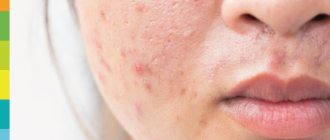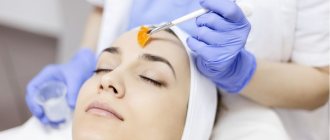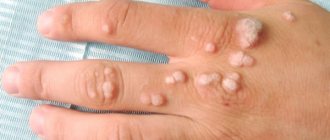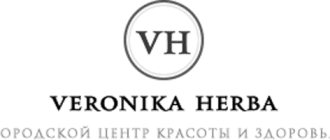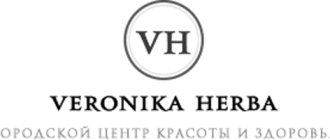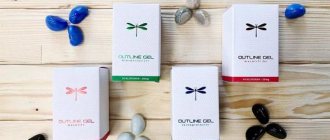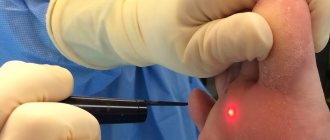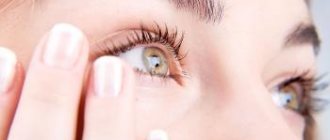Pyruvic or pyruvate peeling is a cosmetic procedure that involves applying a special highly lipophilic preparation based on salts of pyruvic acid (pyruvate) to the skin. The product is indicated for comprehensive care for aging and problematic skin, as well as for the treatment of various skin pathologies: seborrhea, acne grades 1 and 2, hypopigmentation, hyperkeratosis. An intensive course of treatment using pyruvic acid consists of 10 procedures, but most patients notice initial changes in the structure and appearance of the skin after the first session.
The pyruvic peeling procedure is quite comfortable for the patient, as it is not accompanied by pain or severe discomfort. The only disadvantage of this type of peeling is the rehabilitation period, which lasts about two weeks, but after this procedure, skin restoration is much easier compared to more aggressive methods, for example, skin resurfacing using fractional or carbon dioxide lasers.
Pyruvic (pyruvate) peeling
Features of pyruvate peeling
Pyruvate peeling belongs to the group of chemical peels. To carry out the procedure, a drug based on organic ketopropionic acid (pyruvic acid) is used, which has a pronounced exfoliating, bacteriostatic, strengthening and depigmenting effect. The product is an excellent exfoliant and is also involved in melanogenesis - the synthesis of the protein pigment melanin, which is responsible for skin color. This property allows the use of products based on pyruvate (salts of pyruvic acid) in the complex treatment of hyperchromia, a pathology in which the color values of the blood significantly exceed established standards.
Pyruvic acid is actively used in cosmetology and dermatology
Properties of the active substance
Pyruvic acid is the end product of glucose metabolism in the process of catabolic metabolism in the cytoplasm of cells. One molecule of monosaccharide breaks down into two molecules of pyruvic acid, after which, as a result of partial hydrolysis and anaerobic digestion, it turns into lactic acid. Lactic acid has all the properties of alpha hydroxy acids, allowing it to be actively used in cosmetology to treat a number of skin problems.
The main properties of products containing pyruvates:
- destruction of the cytoplasmic cell membrane of pathogenic microorganisms and the creation of conditions incompatible with their life activity (allows the use of pyruvic peeling for the treatment of acne, comedones, acne);
- normalization of the secretory activity of the sebaceous glands and the secretion of sebum (sebum);
- exfoliation (dissolution and removal) of keratinized epidermal cells;
- restoration of covalent bonds at the cellular level, responsible for the binding of hyaluronic acid to water molecules (restoration of hydration);
- participation in melanogenesis.
Pyruvates help restore facial skin hydration
Pyruvic peeling is a superficial cosmetic procedure, as it affects only the upper layers of the epidermis (strata corneum, lucidum and granulosa). If the procedure time is chosen incorrectly, or the concentration of the active substance does not correspond to the skin type and the degree of its sensitivity, the acid may penetrate into the deeper layers of the skin and dermis and cause a chemical burn.
Note! The recommended concentration of pyruvate in products used for pyruvic peeling is 40%. If the skin is not prone to hypersensitivity reactions, the use of drugs with a lower concentration will reduce the effect of the procedure, and more concentrated formulations can cause skin burns.
Line of drugs Mene&Moy System
(Dermatologic Skin Care Laboratories, USA) is one of the most famous professional brands for chemical peeling. It was created and continues to be improved by a plastic surgeon from Brazil, Dr. Romulo Mene, and an American dermatologist, Dr. Lawrence Moy.
The line is certified and has been regularly used in Russia since 1998.
Peeling with glycolic acid content 70%
- Promotes lasting rejuvenating effect
- Intensely moisturizes
- Eliminates signs of photo-induced and biological aging
- Reduces the appearance of hyperpigmentation
- Evens out skin texture
- Serves as preparation for plastic surgery.
Peeling based on glycolic acid 30% , is used for sensitive skin and can be used throughout the peeling period, as well as as several procedures before a course of glycolic peels with a higher concentration.
- Gently exfoliates the upper layers of the epidermis
- Brightens skin
- Evens out complexion
- Shrinks pores
- Has an anti-inflammatory effect
- Helps eliminate follicular hyperkeratosis
- Normalizes the processes of keratinization and secretion of the sebaceous glands
Peeling based on glycolic 50% , kojic and phytic acids for the treatment of hypermelanosis and secondary hyperpigmentation. Thanks to the complex effect, it is possible to discolor the existing pigment and prevent the synthesis of melanin. In addition to the whitening effect, the drug increases the natural level of hydration and prevents age-related changes.
- Has a gentle exfoliating effect
- Lightens the skin, promotes a more uniform distribution of granules
- Eliminates hyperkeratosis
- Increases hydration of the epidermis
- Stimulates cell renewal
melanin in the epidermis
Peeling with glycolic acid is painless. The slight burning sensation is quite tolerable and can be easily eliminated by a directed flow of cold air (fan). After neutralizing the acid, the burning sensation goes away completely.
You can complete this program at any of our clinics:
- Art. m. Mendeleevskaya, Novoslobodskaya, st. Novoslobodskaya, 61, building 1
- Art. m. Tulskaya, st. Pavlovskaya, 18, building 2
- Service Price
- Chemical peels MEDIDERMA (Spain)
- Almond M RUB 3,500
- Almond T 4,000 rub.
- Salicylic 4,000 rub.
- Ferulic 4,800 rub.
- Retinoic (yellow) 7,000 rub.
- Glycolic peels MM System (USA)
- Glycolic 30% RUB 4,800
- Glycolic 50% RUB 4,800
- Glycolic 70% RUB 4,800
- PRX T33 5300 rub.
Our specialists
Kirina Maria Nikolaevna
Drozdova Ekaterina Alexandrovna
Advantages of the method
Pyruvate peeling is a fairly gentle method of caring for aging and problematic skin, while it is highly effective and safe. One of the important advantages of this procedure is the high degree of lipophilicity, that is, the chemical structure of the active component is as close as possible to organic substances and natural elements of the skin. This property ensures rapid and uniform penetration of pyruvates into various layers of the skin and allows you to control the depth of exposure to prevent excessive exposure and chemical damage to the epidermal structures.
Pyruvate peeling is a gentle skin care technique.
High lipophilicity is not the only advantage of pyruvates over other types of chemical peels. The procedure has several other significant characteristics that allow it to be used for skin care of any phototype and with varying degrees of sensitivity. These include:
- good tolerance. Most patients tolerate the procedure quite well, complaining only of moderate tingling during the session itself and slight redness of the skin for 2-3 days after its completion;
- high bioavailability. The drug perfectly penetrates not only into the various layers of the dermis and epidermis, but also into the pilosebaceous structures (hair follicles, sebaceous glands);
- low degree of dehydration compared to other chemical peels. The breakdown into lactic acid molecules allows the use of pyruvate peeling even on dry skin, which is not always possible with other cosmetics;
- stimulating natural skin renewal. Pyruvic acid activates the production of the dermis’ own fibrillar components (elastin and collagen), which helps smooth the skin, even out its contours and rejuvenate.
Pyruvic acid helps smooth out fine wrinkles and stimulates skin regeneration
The pyruvates in the peeling have a gentle effect on the skin, without causing any tightening or peeling effects. Side effects of the procedure in the form of moderate dryness and redness are mild and disappear completely within a few days.
What acids are used for peeling?
- Glycolic
Sugar cane and green grapes are rich in this acid. The substance has a very low molecular weight, which means that it can easily penetrate the dermis and cause a response. This AHA acid is most in demand in cosmetology. It is usually used alone or in combination with other fruit and non-fruit acids.
The action of glycolic acid occurs at the level of the epidermis. The substance activates the production of collagen protein, which affects the structure of the skin tissue. That is why the glycolic variety is called remodeling peeling.
- Dairy
This acid is produced by Lactobacillus bacteria. Lactic acid is found in sour milk, apples, grapes, tomatoes, blueberries and some other berries. In addition, it is included in the natural moisturizing factor (NUF). This acid has a slight exfoliating and moisturizing effect. It is recommended for use on sensitive and dry skin.
- Almond
This acid is obtained from sweet almond grains. It has a mild effect. Mandelic acid can be purchased for professional fruit peeling of the face. In addition, it is included in home cosmetics used for regular care.
- Apple
It is found in large quantities in apples and tomatoes. It is often used to lightly exfoliate epidermal cells.
- Wine (tartar)
This acid is present in grapes, wine, and oranges. The substance exfoliates, whitens and moisturizes.
- Lemon
Found in lemons and other citrus fruits, as well as pineapples. This acid is the heaviest of all fruits. The main quality for which it is valued is its whitening effect (especially in combination with tartaric acid). In addition, citric acid is endowed with antioxidant properties.
- Phytic
Contained in cereals (rice husks, quinoa). Has a mild exfoliating effect.
Indications for the procedure
One of the main indications for pyruvate peeling is acne of degrees 1 and 2. The procedure is especially effective for papulopustular form, as well as sebaceous-horn plugs, consisting of sebum (sebum) and particles of keratinized epidermis. Such plugs are called comedones. They clog the ducts of the sebaceous glands, and dirt and dust settling on top form a black dot on their surface. After several pyruvate peeling procedures, the skin becomes noticeably cleaner, pores become smaller, oily shine disappears, and the skin itself looks fresher and healthier.
Pyruvate peeling is indicated for acne of degrees 1 and 2
Other indications for the use of pyruvic acid preparations in dermatology and cosmetology are:
- age-related and stress-related skin changes (withering, wrinkles, earthy complexion, uneven tone, etc.);
- excessive secretion of sebum and changes in its chemical composition (seborrheic dermatitis);
- inflammatory diseases of the facial skin of non-inflammatory etiology, manifested by the appearance of non-itching red spots, pustules, papules (rosacea);
- premature skin aging;
- hyperchromia and hyperpigmentation;
- skin atony (decreased skin turgor, loss of elasticity, lack of tonic tension of the facial muscles);
- circles and bags under the eyes.
Pyruvic acid preparations are effective against skin aging
Pyruvic exfoliation, like other types of peelings, stimulates cell division in the basal layer of the epidermis, resulting in smoother, lighter and more radiant facial skin. Small wrinkles and skin folds are smoothed out, the skin texture is evened out, so pyruvate peeling can also be used as one of the comprehensive skin care measures for any type of skin without age or gender restrictions.
Note! Pyruvic acid 40% is one of the most effective means in cosmetology for correcting the initial signs of aging in young patients (up to 30 years). Thanks to hydrolysis and further breakdown into lactic acid molecules, the procedure is also recommended for people with extremely dry skin and a tendency to irritation and non-infectious rashes.
What is a fruit peeling for the face?
Not long ago it was noticed that fruit acids have beneficial properties. They began to be used in various branches of medicine. But only after a considerable period of time did fruit acids begin to be used in cosmetology.
Another abbreviated name for these elements – AHA acids – is derived from the full “alphahydroxy acid”. These substances help:
- make facial skin lighter;
- remove excess pigmentation;
- even out complexion.
If you use fruit acids, you can eliminate many skin problems. Scientists have proven that AHA acids can prevent the appearance of natural signs of skin aging. Such signs primarily include wrinkles and loss of tone.
What results can you expect?
Pyruvic acid peeling of the face is essentially a controlled chemical burn, the depth of which is determined by a cosmetologist depending on the existing problems and defects. The degree of penetration of the active substance into the dermal tissue is determined by the time of the procedure, the concentration of pyruvic acid in the composition and the pH level.
Mechanism of action of pyruvate peeling
The therapeutic and cosmetic effect of pyruvate exfoliation is ensured by the stimulating effect of pyruvic acid, which increases the activity of fibroblasts. Fibroblasts are the cells that make up connective tissue. They produce extracellular matrix, mucopolysaccharides, and fibrillar proteins responsible for maintaining skin elasticity and firmness. Pyruvate peeling also removes excess sebum, cleanses pores and normalizes the secretory activity of the sebaceous glands, preventing the re-formation of sebaceous-horn plugs on the face (comedones).
Patients who have completed a full course of recovery with pyruvic acid preparations usually describe the following results from the procedure:
- the skin becomes healthier and smoother, its color and texture are evened out;
- manifestations of acne and post-acne are reduced;
- the skin is cleansed of sebaceous plugs, sebum secretion is normalized;
- fine wrinkles are smoothed out, skin turgor increases;
- signs of increased pigmentation disappear;
- dark circles under the eyes are lightened;
- The normal level of skin moisture is restored, increased dryness, flaking and a feeling of tightness disappear.
After peeling, the skin brightens and smoothes, becomes more elastic
An important effect of pyruvate peeling is increased hemodynamics (blood movement through the vessels). This helps not only to improve the appearance of the skin, but also to normalize cellular nutrition, since it is with blood that epidermal cells receive the necessary vitamins, macro- and microelements, as well as oxygen molecules.
Question answer
Under no circumstances should you carry out the green peeling procedure yourself at home. Only a specialist will be able to correctly assess the condition of the skin, as well as prescribe the concentration of the active substance, and develop an individual post-peeling care regimen. Of course, you can buy a composition for pyruvic acid peeling on your own, but in this case the patient risks causing irreparable harm to his body.
One peeling session with pyruvic acid usually lasts from 30 minutes to 1 hour.
When applying the full course of treatment, the patient experiences the following results: reduction of shallow wrinkles (in some cases, even their complete elimination), tightening of the oval of the face, improvement of the processes of natural renewal of the skin, complexion, disappearance (complete or partial) of age spots, cure acne, eliminating traces of post-acne, normalizing fat secretion in the epidermis, the skin becomes cleaner and matte.
Preparation
Pyruvate peeling refers to procedures that require mandatory preliminary preparation, which is necessary to remove excess sebum, hyperkeratosis (thickening of the stratum corneum of the epidermis) and inflammatory processes. Such manipulations will reduce the risk of irritation and side effects after the procedure, and will also increase its effectiveness, since excess sebum or dead skin cells can significantly impede the penetration of active substances to the required depth.
The skin must be properly prepared for the procedure
In addition to procedural preparation, the patient must also undergo a comprehensive examination (including examination and consultation with a dermatologist) and medication preparation, which includes daily use of products containing glycolic acid. These can be tonics, serums, emulsions or facial gels, which must be selected together with a specialist. Consultation with a doctor is necessary to correctly select the required concentration of acids and prevent chemical damage to the skin that can be caused by products with a high content of glycolic acid.
Depending on the existing problems, preparation for pyruvate peeling also includes cleansers, anti-inflammatory agents and retinoids necessary to regulate keratinization (keratinization) of the skin.
It all starts with a consultation with a dermatologist
Important! Preparation for pyruvic peeling should last at least 2-3 weeks.
What is pyruvic acid
Pyruvic acid is a mild exfoliant, well accepted by tissues, and does not cause irritation. It is included in various professional products and is also used in home care cosmetics due to its wide spectrum of action.
It copes well with hyperpigmentation, eliminates traces of chrono and photoaging.
Peeling compositions have a mild exfoliating effect, without causing dehydration of the skin. As a result, the recovery process occurs very quickly; in rare cases, a slight separation of the epithelial plates is observed.
Effect of pyruvic acid:
- seboregulation;
- whitening pigmentation;
- antiseptic, bactericidal effect;
- comedolytic;
- moisturizing;
- antifungal.
Compositions of pyruvic and lactic acid are used in cosmetology. The specialist chooses the concentration depending on the objectives of aesthetic correction:
- 25% acids in equal proportions - compositions are used to care for young skin, lighten, prevent aging, as well as prepare for other procedures, including deeper exfoliation;
- the formula of 40% pyruvic acid with 5% milk is prescribed for cleansing oily, dense skin, removing sebaceous plugs, sebum regulation, polishing bumpy relief;
- pyruvic acid 50% with 5% lactic acid is prescribed to combat and prevent the aging process, it is possible to restore elasticity, activate collagen synthesis, get rid of pigmentation, freckles.
You can purchase it in various cosmetic stores and online platforms. The cost depends on the manufacturer’s brand, concentration, additional ingredients, volume of solution, price - from 800 rubles. up to 7000 rub.
Stages of the procedure
The pyruvic exfoliation procedure itself takes place in four stages.
Skin cleansing
Before the procedure, it is imperative to remove all dirt, dust, excess sebum, and makeup from the face (it is best not to use any decorative cosmetics at all before going to a cosmetologist). Professional cosmetologists use special mousses for these purposes that have keratolytic and antimicrobial effects. Such products often contain proteolytic enzymes, papain, urea and plant extracts that soothe the skin and prepare it for the effects of acidic compounds.
The first stage is skin cleansing
The main task of a cleanser is to remove all dirt and sebum from the face and prepare the skin for further treatment. Mousses and foams used in salons also trigger cellular renewal processes during the cleansing stage, which increases the effectiveness of the procedure and improves the result. The mousse is applied to the skin with massage movements, and after 1-2 minutes is washed off with plenty of running water.
Applying an exfoliant
A liquid preparation containing pyruvates is applied to the face with quick movements using a disk or tampon according to the following zonal principle:
- frontal zone;
- area under the lower lip and chin;
- cheeks and cheekbones;
- perioral region (the area around the mouth);
- wings of the nose;
- eyelids.
During application, the doctor constantly monitors the skin reaction, and in case of increased burning or the appearance of pronounced signs of irritation, reduces the amount of exfoliant or the procedure time.
Applying the drug to the skin
The patient does not experience any painful sensations during the session, but some may complain of intense tingling and tingling, which usually goes away after the composition is removed.
Neutralization
It is necessary to remove the peeling composition from the face with a special neutralizer with a certain pH level. It is also applied to a sterile cotton swab and generously wiped the skin in the reverse order, starting with the most sensitive areas with thin skin (eyelids, temples, perioral area, etc.).
Removing the composition with a neutralizer
After treatment with the neutralizer, you need to wash your face with cool water and dry thoroughly with a towel or cotton napkin (it is better to do this by lightly blotting your face, without rubbing movements).
After peeling
After the procedure, a restorative and soothing gel or balm based on herbal ingredients (oils and extracts) is applied to the face. Such products have a wound-healing effect, restore the damaged structure of the dermis and epidermis, and stimulate cellular regeneration. A restorative cream after pyruvic peeling is also necessary to prevent dryness and flaking, protect injured skin from the adverse effects of external factors and increase the antioxidant protection of epidermal cells.
After the procedure, a restorative gel is applied
This gel must be applied throughout the entire rehabilitation period, which lasts from 10 days to 2 weeks.
Precautionary measures
Before testing, it is necessary to test the composition for an allergy test to exclude unwanted reactions. also a number of contraindications for carrying out:
- pregnancy, lactation;
- spring-summer period;
- damage to the integrity of the integument;
- viral infections;
- dermatological diseases;
- herpes;
- fresh tan;
- rosacea;
- bronchial asthma;
- pathologies of the respiratory system;
- oncology;
- diabetes;
- individual intolerance.
If the acid concentration is incorrectly chosen, the exfoliation protocol is violated, or the patient does not comply with the recovery rules, complications are possible:
- increasing hyperemia;
- itching, burning, irritation;
- swelling;
- tissue inflammation;
- hyperpigmentation;
- dryness, feeling of tightness;
- exacerbation of acne.
Attention! If side effects occur, consultation and correction of symptoms with a specialist is necessary.
How many procedures do you need to do?
The number of procedures required to achieve a pronounced clinical effect is determined by the individual characteristics of the skin, as well as the purposes of using this type of peeling.
Number of procedures and interval between them
| Purpose of use | Interval between procedures | Recommended number of sessions |
| Combating skin hyperpigmentation | 10 days | 8-10 |
| Treatment of grade 1-2 acne and seborrheic dermatitis | 7 days | 10 |
| Correction of age-related changes and skin atony | 2 weeks | 3-8 |
As a maintenance and preventive procedure, pyruvate peeling is used once every 30-45 days.
To maintain skin tone, pyruvate peeling is done once every month and a half.
ADVANTAGES AND DISADVANTAGES
The main disadvantages of pyruvic peeling, as a rule, include an unpleasant odor and limited use for hyperpigmentation. It has much more advantages:
- Low risk of allergies;
- Efficiency;
- Moisturizing effect;
- Whitening;
- Normalization of the sebaceous glands.
Possible complications
The technique requires a careful approach: failure to comply with the required concentration and duration of application of the exfoliant can lead to burns.
If severe itching, swelling and hyperemia occur, the help of a specialist and the use of medications are needed to combat them.
If an allergy occurs, you should also consult a doctor. As a rule, a complex of antihistamines is prescribed: both in the form of tablets and in the form of ointments.
PROMOITALIA (45%) REJSOL (40%)
Side effects and contraindications
Pyruvate peeling is a fairly gentle procedure, but it also has certain side effects that you need to be prepared for. These include:
- redness (erythema) and dry skin, flaking and a feeling of tightness;
- tingling and burning sensation for 2-3 days after the procedure;
- increased sensitivity to external influences and sunlight.
One of the severe side effects of pyruvic exfoliation is bronchospasms in people suffering from chronic pathologies of the respiratory tract, in particular bronchial asthma. Pyruvic acid has a very pungent odor, so the room in which the procedure is performed must be well ventilated throughout the session.
In asthmatics, pyruvate peeling may cause bronchospasms
Contraindications
Despite its gentle effect on the skin, pyruvic peeling is not suitable for all patients and has certain contraindications, which you need to inform your cosmetologist about. The procedure should not be performed on patients with a long-term or preliminary history of the following pathologies:
- oncological diseases;
- herpetic disease;
- inflammatory skin pathologies in the acute stage;
- diseases of the hematopoietic system;
- diabetes mellitus in the stage of decompensation;
- severe pathologies of the bronchopulmonary system.
Peeling is contraindicated for herpes
Pyruvate peeling is not recommended for patients who require systemic or local hormonal therapy. The use of pyruvic acid (including inhalation of its vapors) is prohibited for pregnant and lactating women and persons with signs of damage to the integrity of the skin at the site of application.
Carrying out at home
Not every girl can go to a beauty salon for a procedure. You can also carry out grape peeling at home. To do this, you need to buy the appropriate tools. Popular among consumers are:
- peeling lotion from the Russian one, the price of which is 3570 rubles per bottle;
- "Pyruvic Peel" from professional cosmetics;
- grape peeling “Spa Technology” from the brand “Tiande” (Tiande), the product is budget-friendly - 300 rubles per tube;
- Israeli cosmetics "Christina";
- ENERPEELPA is a high-quality product containing pyruvic acid in a concentration of 50% and developed according to Enerpil technology;
- the drug "Mediderma" from a Spanish company;
- chemical peeling "Cosmoteros";
- cosmetic products from Mezopharm.
Before starting the procedure, you must carefully read the instructions and proceed step by step, according to the manufacturer’s recommendations. If necessary, watch training videos. You can buy products in city pharmacies or through an online store.
Reviews about the procedure
Katerina Petrova, 34 years old:
A week ago I had a green peeling session. The skin became noticeably smoother, cleaner, and wrinkles disappeared. Time only 45 minutes. The process itself is not the most pleasant. The composition has a pungent odor. I got the effect quickly, I’m happy with the result!
Larisa Artemyeva, 40 years old:
On the advice of a friend, I underwent a peeling procedure with pyruvic acid. The product helped solve the problem of oily skin and smooth out wrinkles. During the session there was slight discomfort and tingling. In general, everything is tolerable, the efforts are justified. Thanks to the cosmetologist for the beauty of my face!
Recovery after the procedure: recommendations
To avoid serious complications and increase the effectiveness of the procedure, after pyruvate exfoliation it is necessary to adhere to certain recovery recommendations.
- Before leaving the house (regardless of the season and time of day), you must apply sunscreen with SPF 30+ to your face.
- To restore damaged epidermal structures and speed up their healing, 2 times a day, the face should be treated with a gel or balm with a regenerating, moisturizing and wound-healing effect (selected together with a cosmetologist, taking into account the individual characteristics of the skin).
- For 1-2 months, visiting the solarium and being exposed to active sunlight is not allowed.
You will have to forget about the solarium for 2 months after the peeling procedure
Note! Crusts and scales that may cover the face after peeling should never be torn off. After the process of cellular regeneration is completed, these crusts will fall off on their own. Failure to comply with this recommendation can lead not only to the appearance of scars and cicatrices, but also to skin infection.
Recipes for homemade fruit peeling for the face
If it is not possible to purchase specialized products, you can make a product from available components. But you need to understand that you won’t be able to get the same effect as in the salon. Therefore, you should not hope for significant changes from home peeling.
- Peeling with lemon
To prepare the composition you will need the following ingredients:
- lemon juice;
- olive oil and rosehip oil.
All components must be taken in equal quantities. Pour the mixture into a container, put it on the fire and heat it up a little. Apply the warm mixture to your face. Wait about ten minutes and rinse with clean water.
- Peeling with orange
To prepare the mixture, you need to use:
- crushed orange;
- ground coffee beans;
- flower honey
Take one tablespoon of each component and mix. Apply the product with massaging movements onto the skin of the face. Leave to act for 10 minutes, then rinse well with water.
- Tropical peeling
Includes:
- 1 banana;
- 1 pineapple;
- 1 kiwi.
All fruits must be peeled and then chopped in a blender. Gently apply the resulting mass onto your face. Leave to absorb for 10 minutes. After this time, the mixture is washed off.
- Apricot peeling mask
The fresh apricot fruits contained in the mask will help your skin acquire an even color and get rid of acne.
To prepare the peeling mixture you need:
- 4 things. apricot (it is better to take fleshy fruits);
- 1 tbsp. l. sleeping coffee (grounds);
- 1 tbsp. l. honey
Grind the fruit to a paste. Add coffee grounds to the resulting mixture, and then honey. Mix everything thoroughly. Apply the mask with massaging movements onto cleansed facial skin and leave for 10-12 minutes. Wash off with cold running water. After several procedures, the skin condition will noticeably improve.
- Lemon-banana mask
During the autumn and winter periods, the skin must be cleansed, moisturized and nourished. Your facial skin will improve significantly if you use banana pulp and lemon juice to care for it.
To prepare the mask you will need:
- freshly squeezed lemon juice (1 tbsp);
- 1 tbsp. l. fermented milk product (kefir, fermented baked milk, yogurt);
- cane sugar (1 tbsp);
- ½ banana.
Take a ceramic container and mash a banana in it. Pour lemon juice, fermented milk product into the resulting mass and add cane sugar. Mix all components thoroughly to obtain a homogeneous paste. Apply the mask evenly to the face. Leave for 5-6 minutes and then wash with cold water.
We recommend
Laser hair removal of the abdomen: contraindications, features of the procedure and care Read more
After using this nourishing mask, the skin will become lighter and cleared of impurities.
- Sweet “strawberry” for your skin
In autumn and winter, a strawberry mask is an excellent therapeutic product for the skin. To prepare it, you need to buy strawberries or use the ones you have in the freezer.
List of ingredients:
- large strawberries (4 pcs.);
- egg (1 pc.);
- freshly brewed coffee (1 tbsp).
Mash the strawberries until mushy. For this purpose, you can use a regular fork. Add egg and coffee to the resulting mass. Mix the mixture thoroughly to form a homogeneous substance. Distribute the mask evenly over the face and leave for 10 minutes. Wash off with cold running water.
The effect of the mask will be noticeable after the first use. You will see that your skin has cleared up. After a 30-day course of procedures, which are recommended to be carried out at least 2 times a week, the result will be visible - an even skin color. Strawberries contain malic acid, which improves regeneration processes, and coffee acts as a scrub.
- Cleaning with kiwi
Kiwi fruits have a cleansing, toning and moisturizing effect. The kiwi peeling procedure improves skin turgor. In addition, after the session, all epidermal cells will be ready to absorb oxygen from the outside.
To prepare the mask you will need:
- ½ kiwi;
- semolina (1 tbsp.);
- banana (several circles);
- vitamin A (1 capsule).
Kiwi fruits and banana should be placed in a container and rubbed well. Then add semolina and retinol to the mixture. It is necessary to cover all problem areas with a thick layer of the mixture. It is advisable to leave the mask on for at least 15 minutes, after which it is washed off with cold water.
Fruit masks, which are made at home, are designed for one-time use, immediately after preparation. The peeling effect may not work if you place the mixture in the refrigerator.
Important: when using fruit peeling for the first time, you need to take a slightly smaller amount of ingredients than indicated in the recipe. Then you can gradually increase the dosage. This is necessary so that the skin gradually gets used to the effects of fruit acids.
Although there are many options for making fruit peeling for home use, cosmetologists still advise buying professional products.
Photos before and after
Photos before and after pyruvate peeling procedure No. 1
Photos before and after pyruvate peeling procedure No. 2
Photos before and after pyruvate peeling procedure No. 3
Advantages and disadvantages
Before you sign up for the procedure, you should find out about its advantages and disadvantages, comparing it with other types of acid peeling.
Pros:
- deeply cleanses pores, gets rid of sebaceous plugs;
- suitable for sensitive, irritated dermis;
- has a moisturizing, rejuvenating effect;
- allows you to get rid of pigmentation;
- has no age restrictions;
- Suitable for all skin types;
- short recovery period;
- the risks of complications are reduced.
Minuses:
- carried out by a cosmetologist according to the protocol;
- discomfort is observed during exfoliation;
- the composition has a specific unpleasant odor.
Peeling with salicylic acid is used to combat acne, lighten the skin, and restore an even tone. There are superficial and superficial-medium types. As a result of application, it is possible to get rid of sebaceous plugs, fine wrinkles, and freckles. The risks of complications are reduced; the procedure is indicated for dark-skinned patients.
Lactic acid is used to rejuvenate the skin, prevent dehydration, and add freshness. Peeling is not effective for hyperpigmentation, scars, wrinkles, and acne. Indicated to prevent aging and maintain a fresh, well-groomed appearance. Used for young skin up to 30 years old.
Retinoic acid differs in acid concentration; it is possible to select an individual composition to solve individual aesthetic skin problems. Prescribed for rejuvenation and lifting of aging skin. Effectively copes with post-acne marks and hyperpigmentation.
Pharmacy drugs
Pyruvic acid is very unstable and easily decomposes in air. It is used in cosmetics in combination with stabilizers such as vitamin C, azulenoic acid and its derivatives.
The specific smell is masked with essential oils (blood orange, grapefruit).
The products are packaged in ampoules designed for one use or in bottles with a dispenser.
Clarena cream and serum
Cream (Clarena), which contains 3% pyruvic and 10% azulenoic acids, is intended for intensive rejuvenation of the epidermis. It is used at night, applied to a dry face after cleansing.
Recommended after 40 years of age with obvious signs of aging and fading.
Serum with glycerin in ampoules of 5 ml (Clarena) with a concentration of 5% for the treatment of oily seborrhea, acne, used at night.
The product is recommended at any age in combination with Panthenol cream, which is applied in the morning.
Mesopharm Professional
Serum with a 5% concentration , enriched with retinol and ascorbic acid (Mesopharm Professional) is used in the treatment of rosacea, acne, age spots, and the initial stage of photoaging.
The drug is used starting from 16 years of age in the presence of problematic epidermis of oily and combination type.
Biomaris
Mask containing 10% pyruvic acid (Biomaris) , sealed in 5 ml ampoules. Purposes of use: removal of acne, comedones, rejuvenation (lifting), lightening, prevention of photoaging.
The product is used in combination with an appropriate cream (Clarena) to increase the anti-aging effect in women with noticeable aging of the epidermis or separately from it, applying a moisturizing gel after use.
Before using pharmaceutical drugs, it is advisable to consult a professional cosmetologist.
Patient reviews
On the forums there are mostly positive reviews after grape peeling.
The user writes about the good effect of cleansing the face and narrowing pores after using Teana grape peeling.
The participant writes about the high cost and necessity of the course. But the number of sessions is selected individually; not in all cases it is necessary to undergo all 10 procedures.
The review compares the recovery period after retinoic and grape peels.
The user writes that with frequent exfoliation, problems with capillaries are observed.
Opinions of cosmetologists
Cosmetologists share their experience of using pyruvic acid.
The specialist advises to carry out 2-3 superficial pyruvic peels before retinoic peeling.
A cosmetologist describes the use of pyruvic peeling with fractional mesotherapy.
Experts question the possibility of replacing one acid peel with another. Each has its own indications for use.

